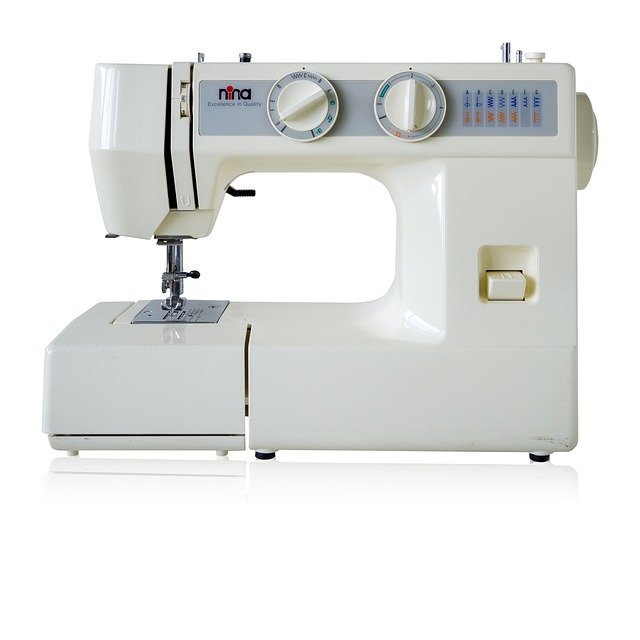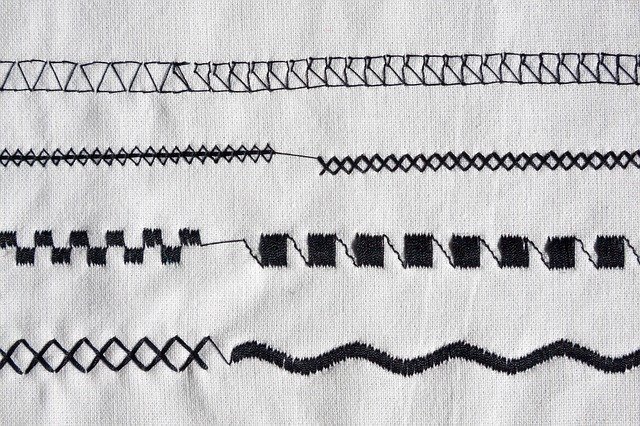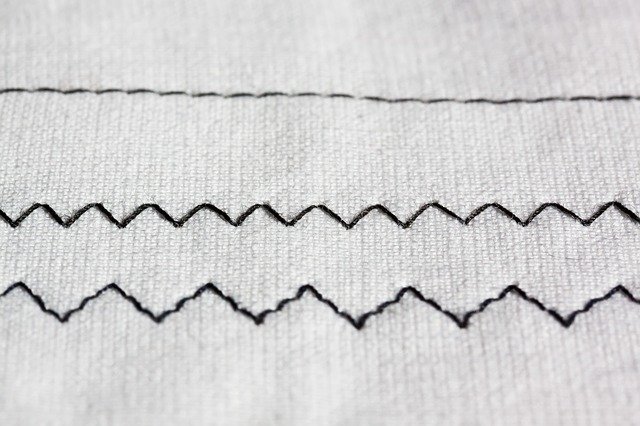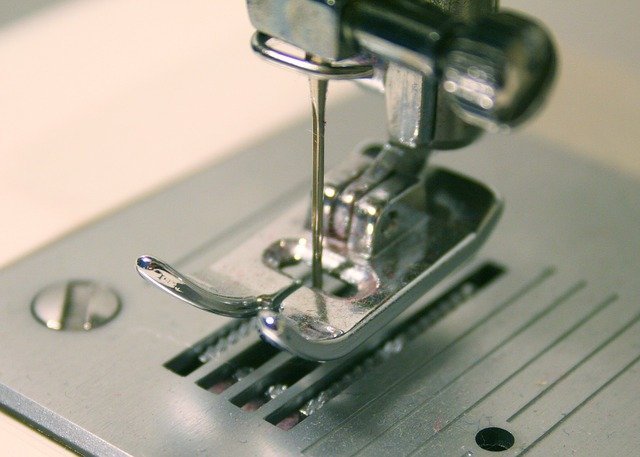

Hola hola, gracias por pasar a leer y primero que nada quiero agradecer a todos en esta comunidad de #needleworkmonday con su apoyo y votos en mis publicaciones.
Eso me motiva a crear mejores post para todos ustedes.
Si has decidido venir a aprender, hoy es un día especial.
Hablemos de la Máquina de coser
La máquina de coser es una herramienta que a pesar de los años no ha cambiado, siguen existiendo talleres y aunque las industrias ahora usan mano de obra robot la costura aún sigue en pie.
Cómo les dije hoy es un día especial con esos 40 Tips y consejos que debe tener en cuenta para usar tu máquina de coser.
 tipos de puntadas en un máquina casera, imagen de pixabay.com
tipos de puntadas en un máquina casera, imagen de pixabay.com
40 TIPS Y CONSEJOS PARA USAR CON TU MÁQUINA DE COSER
Vamos a empezar con 2 tips que te cambiaran la vida, esto hizo que dejara de renegar con las pobres máquinas.
- Si tu máquina cose mal arriba, el error y el fallo técnico es abajo.
- Si tu maquina cose más abajo tu fallo técnico es arriba.
- Usa las agujas según su número.
- La parte plana va hacia atrás.
- La ranura va hacia adelante.
- Aguja número 18 para jeans y lona.
- Aguja punta Roma para lycra y elásticos.
- El uso de las puntadas debes practicar antes de comenzar en la tela.
- Las agujas vienen por números más bajo el número se usaran en telas más finitas.
- La Correa debe cambiarse cada 6 meses o un año.
12 Mantén tu máquina en su caja o tapada, recuerda que tiene un motor engrasado que necesita estar libre de espacio. - La distancia para las costura más usada es la del ancho del mismo pie de la máquina.
- No uses la máquina de coser descalzo, la seguridad es primero y así evitas un choque de electricidad.
- Usa aguja doble para coser dobladillo de tas de punto.
- Utiliza zigzag para rematar las costuras.
- Si tu máquina es de brazo libre es decir que tiene un pequeño cajón y se quita, este se puede usar para hagas ruedos de pantalón y mangas fácilmente.
- Todas las máquinas tienen una presión del pie... Para telas elastizadas usa menos presión así no queda estirada la tela formando pequeñas ondas.
- Una máquina casera si bien aguanta trabajo unas 5 horas debes dejar enfriar el motor para que descanse... Así también enfría la correa y no se estira tan rápido.
- Usa los alfileres de forma horizontal para coser así no los tienes que quitar al coser.
- Conoce la marca de tu maquina y pide sus accesorios según cada marca.
- La aguja número 9 se usa para gasas, chiffon, micro tul y tafetán.
- Agujas número 11 para satén, sedas y telas de vestir como el razo.
- Agujas de número 14 para algodón plano y telas de sábanas o camisas.
- Agujas número 16 y 18 para telas gruesas.
- Las agujas tendrán punta regular para tejidos cerrados y agujas de bola o punta redondeo para tejidos abiertos como el lino fino.
- Para un acabado profesional en máquina casera al coser tela de franela puedes usar abajo hilo de overlock y te dejará una costura libre.
Bien hasta ahora como vamos???
Hemos repasado uno tips básicos y muy importantes para las que amamos coser.
Así que antes de seguir con el resto de típs vamos. Hablar de las máquinas de coser caseras que puedes adquirir y que hay en el mercado.
Máquina de coser casera recta y zigzag
Como todas las máquinas ésta es la más común al comprar porque nos ayuda a rematar costura y sus accesorios
 pintadas recta y zigzag, imagen de pixabay.com
pintadas recta y zigzag, imagen de pixabay.com
Máquina overlock
Aunque parezca mentira hay máquinas caseras para rematar como un profesional. No tienen la misma velocidad pero si la misma puntada característica.
Triple transporte
Así se conoce la máquina de coser cuero, su versión casera es igual de poderosa que una industrial y puede llegar a pesar hasta 14kilos.
CON ESTE BREAK VAMOS CON EL RESTO DEL TEMA

Segunda parte y otros 15 tips y secretos de tu máquina de coser
- Para coser el cuero hay un secreto bien guardado, unta con crema de manos el pie de tu máquina así desliza y no se pegará jamás la pieza que estés cosiendo
- Llenar la bobina trata de no llenar a tope o al máximo la bobina así si las guardas no se sale el hilo.
- No uses bobinas de plástico si la bobina que trajo tu máquina son de metal.
- El ajuste de la costura correcto permite ver solo una parte del hilo, es decir arriba solo verás el hilo de arriba y abajo el de abajo.
- Para prendas de niños usa hilo 100% algodón así jamás la prenda perderá su forma.
- Prueba la costura en un pedazo de tela antes de empezar, eso sí un pedazo de tela del que usarás.
- Ajusta bien tu prensa telas, hay máquinas que puedes elevar el prensa telas esto te dará margen a usar grosores distintos y mejor costura.
- Usa una brocha para limpiar el porta bobinas, las fibras que entran y se quedan llegan a formar bolas de fribra y grasa. No uses paños mojados.
- El plato de medida cerca de tu aguja de la máquina te servirá de guía para ruedos y anchos de costura así como lograr una costura recta.
- Entra la aguja antes de comenzar a coser. Así un arranque rápido no hará que hagas una costura fuera de lugar o peor aún que puedas pinchar un dedo.
- Si tu máquina es de trabajo intenta usar una máquina para un fin parecido, trajes de baño, ropa deportiva y ropa interior.
12 combinar acciones implica que la máquina desajuste más rápido. - Después de acolchar usa una aguja nueva, la guata y la goma espuma quita el filo de la aguja.
- Se te ha hecho un rollo de hilo debajo? Puede que tú lanzadera este desajustada, si no sabes ajustar llévala a revisar.
- Usa buena luz además de la luz de la máquina así no dañas tu vista.
Bonus El pie de dobladillo en cortes curvos como una falda doble círculo hace un ruedos con ondas vistosas.
Hey esto ha sido una máster clase!, si tienes dudas comenta, estoy para ayudarte a mejorar.
Gracias por venir por acá y aprender de un arte, un hobby, un oficio y una profesión tan linda como. Las costura.
Hay infinidad de proyectos coméntame que gustaría aprender y haré un post con mucho entusiasmo
Nos leemos pronto! 😀

Hi hi, thanks for stopping by to read and first of all I want to thank everyone in this #needleworkmonday community with their support and votes in my posts.
That motivates me to create better posts for all of you.
If you have decided to come to learn, today is a special day.
Let's talk about the sewing machine
The sewing machine is a tool that despite the years has not changed, there are still workshops and although industries now use robot labor, sewing still stands.
How I told you today is a special day with those 40 tips and advice that you should keep in mind to use your sewing machine.

stitch types on a pixabay
40 TIPS AND ADVICE TO USE WITH YOUR SEWING MACHINE
Let's start with 2 tips that will change your life, this made him stop denying the poor machines.
- If your machine sews badly above, the error and technical failure is below.
- If your machine sews lower, your technical failure is up.
- Use the needles according to their number.
- The flat part goes to the rear.
- The slot goes forward.
- Needle number 18 for jeans and canvas.
- Blunt needle for lycra and elastics.
- The use of stitches should be practiced before starting on the fabric.
- Needles come by numbers lower than the number they will be used on finer fabrics.
- The strap should be changed every 6 months or a year.
12 Keep your machine in its box or covered, remember that it has a greased motor that needs to be free of space. - The distance for the most used seams is the width of the same foot of the machine.
- Do not use the sewing machine barefoot, safety is first and thus avoid an electric shock.
- Use a double needle to hem the knits.
- Use zigzag to finish off the seams.
- If your machine has a free arm, it means that it has a small drawer and it can be removed, this can be used to easily roll up pants and sleeves.
- All machines have foot pressure ... For stretchy fabrics use less pressure so the fabric is not stretched forming small waves.
- A homemade machine, although it lasts for about 5 hours, you must let the engine cool down to rest ... This way it also cools the belt and it does not stretch so fast.
- Use the pins horizontally to sew so you don't have to remove them when sewing.
- Know the brand of your machine and order its accessories according to each brand.
- Needle number 9 is used for chiffon, chiffon, micro tulle and taffeta.
- Needles number 11 for satin, silks and clothing fabrics such as razo.
- Number 14 needles for plain cotton and linen or shirt fabrics.
- Needles number 16 and 18 for thick fabrics. 24. The needles will have a regular point for closed fabrics and ball or round point needles for open fabrics such as fine linen.
- For a professional home machine finish when sewing flannel fabric you can use overlock thread below and it will leave you a free seam.
Well so far how are we going ???
We have reviewed one basic and very important tips for those of us who love to sew.
So before continuing with the rest of the tips, let's go. Talk about the homemade sewing machines that you can buy and that are on the market.
Homemade straight and zigzag sewing machine
Like all machines this is the most common when buying because it helps us to finish sewing and its accessories.

painted straight and zigzag pixabay
Overlock machine
Oddly enough, there are homemade machines to finish off like a pro.
They do not have the same speed but the same characteristic stitch.
Triple transport
This is how the leather sewing machine is known, its home version is just as powerful as an industrial one and can weigh up to 14 kgrms.
WITH THIS BREAK WE GO WITH THE REST OF THE THEME

Second part and 15 other tips and secrets of your sewing machine
- To sew leather there is a well-kept secret, smear the foot of your machine with hand cream so it slides and the piece you are sewing will never stick.
- Filling the bobbin try not to fill the bobbin to the top or to the maximum, so if you keep them the thread will not come out.
- Do not use plastic spools if the spool that your machine brought is metal.
- The correct seam adjustment allows you to see only a part of the thread, that is, you will only see the upper thread at the top and the bottom thread at the bottom.
- For children's garments, use 100% cotton thread so the garment will never lose its shape.
- Test sewing on a piece of fabric before you begin, yes a piece of fabric that you will use.
- Adjust your fabric press well, there are machines that can raise the fabric press this will give you room to use different thicknesses and better stitching.
- Use a brush to clean the bobbin holder, the fibers that enter and remain form fiber and grease balls. Don't use wet cloths.
- The measuring plate near your machine needle will guide you for hemlines and seam widths as well as achieving a straight seam.
- Enter the needle before starting to sew. This way, a quick start won't cause you to sew out of place or worse yet, you can prick your finger.
- If your machine is for work, try using a machine for a similar purpose, bathing suits, sportswear and underwear.
12 combining actions means that the machine misadjusts faster. - After quilting use a new needle, the wadding and foam rubber removes the sharpness of the needle. 14. Has a roll of thread become underneath? Maybe your shuttle is out of adjustment, if you do not know how to adjust take it to check.
- Use good light in addition to the light from the machine so you don't damage your eyesight.
Bonus The hem foot in curved cuts like a double circle skirt makes a hem with showy waves.
Hey, this has been a master class! If you have questions, comment, I am here to help you improve.
Thank you for coming here and learning about an art, a hobby, a trade and a profession as beautiful as sew things.
There are countless projects tell me what I would like to learn and I will make a post with great enthusiasm
We read us soon! 😀

¡Hola Karen! Todos esos consejos son muy útiles para las que usamos máquina de coser a diario, creo que la mayoría de ellos los tengo en cuenta. También agregaría que si coses con zapatillas o un zapato bien puesto (me refiero a no ojotas o pantuflas) podes regular mejor la velocidad de la maquina con el pedal. Lo único que no comparto es coser sin quitar los alfileres, esto me da miedo ya que si la aguja golpea los alfileres se puede romper y es un peligro, por lo tanto siempre los quito.
Gracias por compartir toda la información. Saludos ❤️.